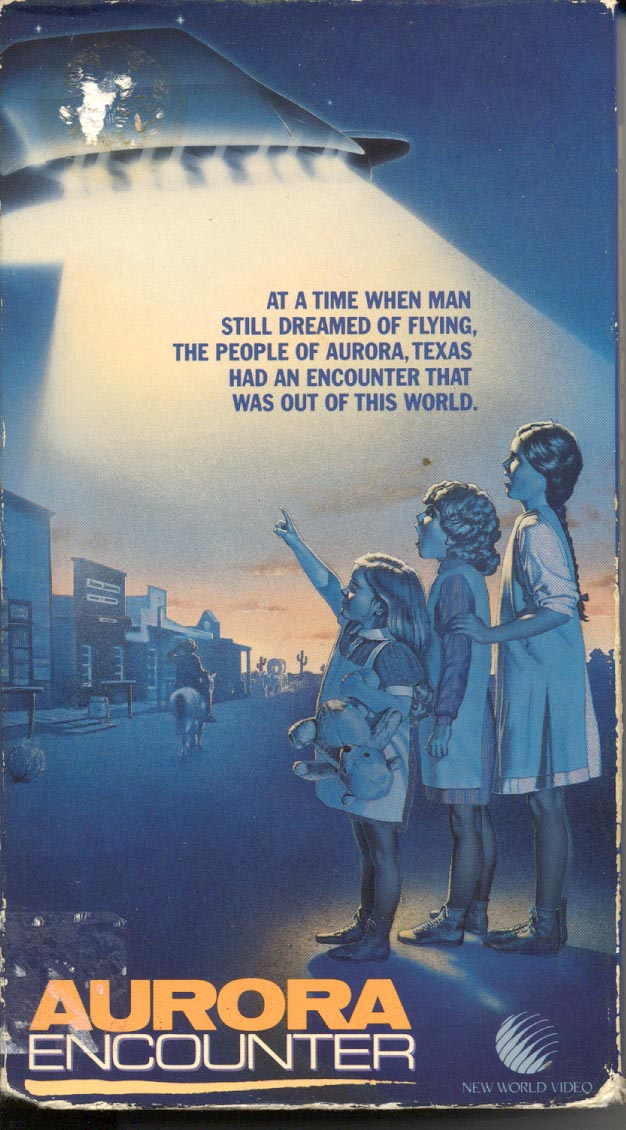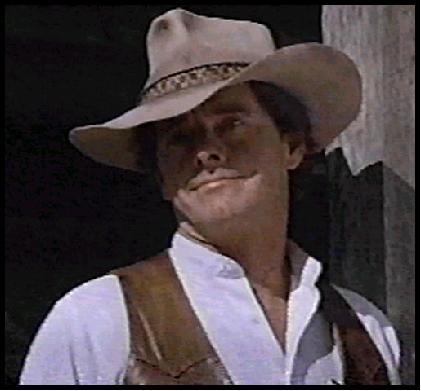Peter
Brown in:
AURORA ENCOUNTER
1986
Written by Jim McCullough
Jr.
Directed by Jim McCullough
Sr.
Co-produced by Jim McCullough
Jr. & Sr.
Executive Producers
Fred Kuchner & M.
Sanousi
CAST
PETER BROWN as Sheriff
Temple Ferguson
JACK ELAM as Charlie
Henkins
CAROL BAGDASARIAN as
Alain Peebles
DOTTIE WEST as Irene
MICKEY HAYS as the Aurora
Spaceman
MINDY SMITH as
Sue Beth
CARLY McCULLOUGH as
Ginger
TRACY KUEHNERT as
Becky
WILL MITCHELL as
The Ranger
GEORGE 'SPANKY' McFARLAND
as Governor
Paula Barrett as Secretary
Foster Litton as Bartender
Kaye Winters as Mrs.
Mikeska
Lois Lane as 1st
Woman
Ann Hazlett as 2nd Woman
Charles B. Pierce
as Preacher
Don Pirl as Rowdy #1
Cyrus Theibeault as Rowdy
#2
Rick Phiffer as
Drunk
Big Charles Gibbons as
Tramp
Bob Lewis as Printer
Big Boi Ridgeback as
Moon Dog
|


|
This odd little cross-genre western/scifi
movie is very loosely based on reports of a supposed alien sighting in
the little Texas town of Aurora. It opens on the funeral of
Ben Peebles, the owner of the local newspaper. His daughter Alain
is the local school teacher and the Sheriff's girlfriend. She plans
to add newspaper woman to her resume and keep her father's paper going.
The Sheriff, also called Temple, is a little skeptical of her ability
to handle all those roles. But she's portrayed as a dynamic "modern"
woman who rides a bicycle and is an enthusiastic school teacher who encourages
girls as well as boys to get a good education.
Three of the female students figure
heavily into the story, especially Sue Beth.
Jack Elam is Charlie the town
drunk who sells an alcoholic elixir for a living. When he tries to
get Alain Peebles to give him a bigger ad in the paper, she reminds him
how much trouble her father had collecting the payment for the small ad.
It is then that Alain notes how she needs a hot story to get the paper
back on it's feet.
Of course, the landing of an alien
craft is just such a story. The first to spot him is the Widow
Irene who finds him peeking in her window.
Temple is clearly skeptical about
the imaginings of a lonely widow living on her own. Alain smells
a story.
Alain finds a circle that looks
like a mysterious landing spot. Temple is still skeptical.
Temple warns his sweetheart not
to print anything until she has hard evidence. They have words over
this but when she asks him if she'll see him that night, he utters what
becomes the affectionate assurance between them, "Of course, one thing
has nothing to do with the other."
The next sighting is by the ever-curious
Sue Beth. She sees the little alien get into his ship and finds a
prism/crystal he left behind.
Charlie is at home drinking his
elixir and playing checkers with himself. The alien drops by for
a game of checkers . . .
And a little of the elixir.
Sue Beth shows Alain the crystal,
but won't let her keep it.
Alain waxes eloquent on the subject
of space ships. Temple overhears and applauds her efforts.
But he doesn't think she should
print anything until she gets some hard evidence.
She announces her intention to
go to the governor to get a statement for the paper. Temple finds
her exasperating but has a "what can I do, I love her" attitude.
Alain gets an audience with the
governor on the pretext of being a reporter from the New York Times.
She asks him for a statement about the alien ship seen in Aurora.
When he has no comment, she writes that down as though it was a meaningful
response.
After Alain leaves, the governor
calls in his private Texas Ranger and sends him to Aurora to check things
out and expose the story as a fraud. In the unlikely event the story
is true, he is to dispose of the problem. It's not clear why he thinks
an alien would be a barrier to his political ambitions but apparently he
does.
Alain comes home bubbling with
pleasure over the simple no comment statement which she intends to use
to benefit the story. Temple doesn't think that's right or that she
has the evidence to justify the story of aliens landing in Aurora.
We have a few interludes, watching
the alien interact with cows and dogs and seeing Alain, inspired by the
stories of space ships, try out a flying machine of her own design.
She maintains her enthusiasm,
despite landing in the pond at the bottom of the hill.
Trouble in the person of the Governor's
Ranger comes to town. He questions Charlie.
Charlie returns home to again
entertain the alien who trades him a dog he doesn't want for his hat.
In the meantime, the three girls
go exploring and fall into a cavern which has mysterious writing on the
walls.
While a cave-in threatens the
girls and cuts off their exit, the Ranger is out trying to hunt down the
alien.
The alien then goes to the aid
of the trapped girls, apparently signaled by the crystal and uses
his powers to levitate them out of the cavern.
The sheriff goes out and reinterviews
the widow and appears to be more perplexed than ever.
When Alain hears the story of
the girls' rescue, she has an idea about the prism/crystal. She starts
taking prisms off a lamp in her office.
As she's trying to explain her
plan to Temple and the girls, the Ranger comes in making inquiries about
the alien.
Temple recognizes him as a Ranger
and asks him what he wants. The Ranger says he's going to run
the story to ground and if there's anything to it, he's going to take down
the alien. Temple tells him, "Not in my town."
Alain gets the whole town out
holding prisms to the sky and waiting for the ship to respond.
Temple maintains his skepticism
but is supportive of his sweetheart.
When something does appear in
the sky, he's amazed, as is the whole town.
However, as the little alien walks
out to greet Sue Beth who goes forward to give him the crystal, a shot
rings out.
Temple turns gun drawn and confronts
the Ranger who fired the shot. The Ranger puts his hands up but the
damage is done.
The little alien is dead.
And for some unexplained reason (probably
related to shooting schedules and not plot) it's now night.
And so the story ends as it began,
with a funeral.
Only on this occasion we see some
kind of unexplained glowing light which suggests the alien's soul or spirit
is returning to his place of origin.
NiteOwl Review: This was a
harmless, silly, not very interesting, low-budget movie. It had the
simplicity of a Disney movie but without the charm despite the appearance
of Jack Elam and Dottie West. It was more disappointing to us because
it was Peter's only full length Western (unless you count the movies made
from Laredo episodes for overseas distribution). Of course,
it it was nice to see him in Western garb, riding a horse (briefly) and
drawing his gun (once) but it just reminded us that he still had what it
takes to make a Western and made us long for a real one. (And anyone
who's seen Peter compete in cowboy mounted shooting recently can see he
still has what it takes to make a Western.)
We had to wonder, if the producers were
such good friends of the family of the boy playing the alien. whether the
whole thing was like a grossly expensive gesture along the lines of the
make-a-wish foundation's practice of sending terminally ill children to
Disneyland.
Cast Notes: The most interesting
part of the movie is the boy who played the alien with not much added to
make him an alien except some ear prothesis. Mickey Hays was a personable,
upbeat little boy suffering from progeria, a genetic condition which virtually
guaranteed he would not live to see twenty. He appeared on the Phil
Donahue show several times in the middle eighties wearing a baseball cap
and cheerfully answering questions about his condition. During
his second appearance, other children suffering from the same condition
also appeared. We think there was a third appearance promoting this
movie. According to Peter, Mickey's family and the producers are
close friends. His appearance in this movie was most certainly the
highlight of his short life. Peter said that during the scene where
he carried the alien, it was like picking up a bird because Mickey's bones
were so light (as the result of osteoporosis).
A website
for the syndrome states: "Hutchinson-Gilford Progeria Syndrome
is an extremely rare genetic disease that accelerates the aging process
to about seven times the normal rate. Because of this accelerated aging,
a child of ten years will have similar respiratory, cardiovascular, and
arthritic conditions that a 70-year-old would have. Currently, there is
no cure for this disease, and because of its rare nature, no definitive
cause can be pinpointed.
"Progeria affects between 1 in 4 million
(estimated actual) and 1 in 8 million (reported) children, with a total
reported incidence of just over 100 in the century since it's been identified.
There are currently between 30 and 40 known cases worldwide of Progeria.
Children from all races and cultures from around the world have been affected.
Some physical features of Progeria children include dwarfism, wrinkled/aged-looking
skin, baldness, and a pinched nose. Mental growth is equivalent to other
children of the same age. Most children with Progeria live no longer than
their early teenage years, though one or two have lived to be as old as
20 or 21."
Contact us at:
outrider@peterbrown.tv


